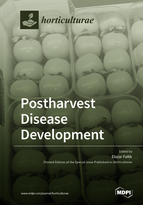Postharvest Disease Development: Pre and/or Postharvest Practices
A special issue of Horticulturae (ISSN 2311-7524). This special issue belongs to the section "Postharvest Biology, Quality, Safety, and Technology".
Deadline for manuscript submissions: closed (15 October 2018) | Viewed by 62844
Special Issue Editor
Interests: postharvest physiology; pathology; sensory and biochemistry issues; fruit; vegetables
Special Issues, Collections and Topics in MDPI journals
Special Issue Information
Dear Colleagues,
Postharvest losses of fresh produce have always been an obstacle in agriculture. Roughly one-third of global fresh fruits and vegetables are lost because their quality has dropped below an acceptance limit. Losses include any change and/or damage in quantity and quality of produce from the moment of harvest until consumption.
Consumers worldwide have become more and more concerned about the quality of fresh and fresh-cut fruits and vegetables. Product quality is a complex issue: it encompasses visual characteristics such as size, color, shape, defects and rots, all encompassed in general appearance; physical and chemical properties, such as texture, and mineral and vitamin contents; and flavor and other organoleptic characteristics. Thus, fruits and vegetables are also appreciated for their beneficial health effects in. Once produce is harvested, postharvest handling practices do not improve the quality attained in the field; they only can slow the rate at which deterioration occurs. Physiological and pathological deterioration of a produce after harvest can play a principal role in a consumer’s decision to purchase.
Postharvest quality and shelf life of fresh produce also are determined before harvest. Factors that include weather, soil preparation and cultivation, soil type, cultivar, irrigation and fertilization practices, and crop loads affect the quality and flavor properties of harvested fresh produce. However, postharvest quality is also affected by many practices during and after harvest such as temperature management, controlled and modified atmosphere, coating, physical treatments, biocontrol, and more.
This Special Issue on “Postharvest Disease Development: Pre and/or Postharvest Practices” intend to provide novel insight into fresh produce disease development with a specific focus on above aspects. Your contribution to this topic through literature review or original research paper that deal with either pre or postharvest practices that affect disease development after harvest are welcomed on all fresh produce.
Prof. Dr. Elazar Fallik
Guest Editor
Manuscript Submission Information
Manuscripts should be submitted online at www.mdpi.com by registering and logging in to this website. Once you are registered, click here to go to the submission form. Manuscripts can be submitted until the deadline. All submissions that pass pre-check are peer-reviewed. Accepted papers will be published continuously in the journal (as soon as accepted) and will be listed together on the special issue website. Research articles, review articles as well as short communications are invited. For planned papers, a title and short abstract (about 100 words) can be sent to the Editorial Office for announcement on this website.
Submitted manuscripts should not have been published previously, nor be under consideration for publication elsewhere (except conference proceedings papers). All manuscripts are thoroughly refereed through a single-blind peer-review process. A guide for authors and other relevant information for submission of manuscripts is available on the Instructions for Authors page. Horticulturae is an international peer-reviewed open access monthly journal published by MDPI.
Please visit the Instructions for Authors page before submitting a manuscript. The Article Processing Charge (APC) for publication in this open access journal is 2200 CHF (Swiss Francs). Submitted papers should be well formatted and use good English. Authors may use MDPI's English editing service prior to publication or during author revisions.
Keywords
- disease control
- disease development
- fresh produce
- pre harvest practices
- postharvest practices
- quality
- shelf life
- storage






